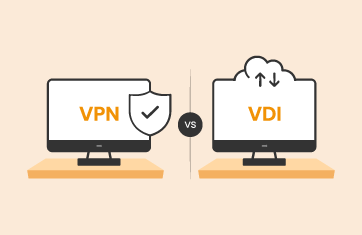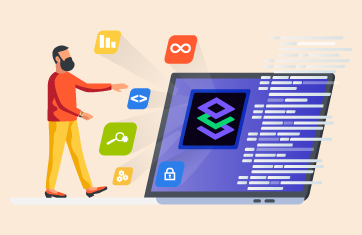| Watch the webinar: We’ve brought in CTP, Barry Schiffer, EUC evangelist, Rachel Berry and digital workspace expert Eric Haarvastein to talk about what the survey results mean and what trends we’re seeing for the future of digital workspaces. Join them for this fireside chat and bring your questions along. |
Where the respondents came from
The Digital Workspace Survey conducted by eG Innovations and xenappblog is one of the largest surveys of its kind, generating over 1,050 responses from IT professionals around the world.

How were respondents associated with digital workspaces?
62% of the respondents worked for organizations using digital workspaces for their employees. The remainder came from various types of organizations providing support for digital workspaces.

Below are just a few highlights from the report which is packed with insights. Don’t forget to register for the webinar where we’ll have a panel of experts discussing the results in more detail. You can also download the full report here.
How are digital workspaces being deployed by businesses?
Understanding how businesses are currently deploying digital workspaces helps serve as a benchmark for future editions of this report, as we will see if migration to the cloud is progressing or hitting a roadblock. Additionally, we will be able to see the adoption or the rejection of new technologies over time.
- 1 Windows RDS is the most commonly used digital workspace technology
- 2 There is still a lot of resistance to moving to the cloud for digital workspaces
- 3 Container technologies are generating a surprising amount of interest for digital workspace technologies
- 4 Most businesses had to make changes to their digital workspace environment
- 5 Every IT team struggled with employee internet connectivity issues
- 6 Troubleshooting IT problems is really, really difficult when you’re not in the room
- 7 Native performance monitoring tools are the preferred means to monitor digital workspaces
- 8 There is still a proliferation of IT monitoring tools being used by IT departments
- 9 IT Teams are not convinced about ‘self-healing’ tools or tools that automatically take corrective action
1. Windows RDS is the most commonly used digital workspace technology
The legacy base technology for remote access is still a very important workhorse for many. However, Citrix Virtual Apps and Desktops weren’t too far behind. Generally, the larger the business, the more it preferred to use Citrix or VMware Horizon.
Although Citrix Cloud has been available for many years, only 17% of respondents said their company (or clients in the case of technology providers) were using it; however, with some incentivized licensing pricing from Citrix around this product we’ll be watching how this grows as renewals come up over the next year, the pricing certainly means many will be having a Citrix Cloud discussion internally.

| Should your business consider moving to Citrix Cloud or are you already thinking about it? Citrix Technology Professional, George Spiers answers all your questions about the pros and cons of moving to Citrix Cloud. |
2. There is still a lot of resistance to moving to the cloud for digital workspaces
Analysts, consultants, and technology providers have been talking about cloud migration for a decade now, yet 43% of companies say they either have no plans to migrate to cloud-based digital workspaces or will use it as a backup or add-on to their on-premises deployments. One of the biggest reasons cited for this is the ongoing cost associated with cloud deployments.

3. Container technologies (Docker, Kubernetes) are generating a surprising amount of interest for digital workspace technologies
There was reasonable and expected interest in new Citrix & VMware technologies, FSLogix Profiles, and Hyper Converged Infrastructure (HCI), however we were somewhat surprised that interest in vGPU technology and containers were tied as the two technologies that IT professionals are most interested in when it comes to digital workspaces.
Previously the domain of applications, it’s interesting to see how containers might evolve to support digital workspaces as well – this is definitely one we’ll be discussing on our webinar about this survey!

| Join our panel of experts as they discuss why new technologies like containers are such a hot topic in digital workspaces right now and what it means for virtualization. |
Digital workspaces and the pandemic
Like everyone else, we look forward to the day when the pandemic is consigned to the history books and we can go out and meet everyone safely again. If you work in the IT department, you’re probably looking forward to never seeing another helpdesk ticket where employees are sending non-stop messages that the “application is slow.”
What we really wanted to find out from this survey is whether the pandemic served as the great change for businesses that had otherwise delayed IT projects and kicked them down the road. Were businesses ready to go from a handful of people working remotely to 100% of the workforce being remote? Here’s what the numbers say…
4. Most businesses had to make changes to their digital workspace environment
While only 16% of businesses had to adopt a digital workspace for its employees for the first time, this isn’t too surprising given that the survey was about digital workspaces. More interesting was that even though most businesses already had a digital workspace set up, 82% of them had to make changes to their deployment.
41% of respondents said they had to add new seats to support the remote workforce. Remarkably, only 18% said that the performance of digital workspaces had become important or a priority for the management team. This is short-sighted in our opinion, as a lack of investment here can impact the overall employee productivity as they struggle with slow applications.
Anecdotally though, we are increasingly hearing requests around insights and metrics associated with user productivity and behavior. Possibly this is a reflection on organizations struggling to change strategies and priorities on short time-scales – this is definitely a topic we’ll be inviting debate around on our webinar.

| Listen to our panel of experts, Barry Schiffer, Rachel Berry and Eric Haavarstein as they discuss the challenges IT teams have faced during the pandemic and the challenges that the future will bring. |
5. Every IT team struggled with employee internet connectivity issues
The digital divide between those with fast, reliable internet connections and those still on spotty DSL connections is real. Personally, I’ve been struggling with an internet connection in the UK that gives me 10 Mbps download and a sizzling 512 Kbps upload – barely enough for a video call. I guess that’s what you get when you live in an apartment block with 400 other people pushing their data down the same internet cables.
The survey respondents know about this problem all too well. 43% said that employees’ poor internet connection was the number one problem they had to face during the pandemic. Incredibly, 14% of respondents said they faced no IT challenges during the pandemic.

6. Troubleshooting IT problems is really, really difficult when you’re not in the room
If you work in IT, it will come as no surprise that the thing IT professionals said changed the most during the pandemic was that it was more difficult to troubleshoot IT problems remotely. Not only did support staff face the challenges of debugging users remotely, but they themselves were also often working solo and remotely without the back-up of a team of colleagues around them.
Another change that many respondents saw was that management was suddenly a lot more interested in digital workspaces, presumably to make sure the business can continue to function.
17% of respondents were asked to provide employee productivity reports. In some cases this reflects that management still doesn’t trust a remote, work-from-home workforce. However, deeper discussions with some of our customers revealed they were using our products to pro-actively understand and support their users and monitor concerning trends such as users working strange or lengthened hours.

| How do you troubleshoot digital workspaces and underlying infrastructure when you’re remote? Put your questions to our panel of experts on the upcoming webinar where we discuss what these results mean for the future of IT. |
Performance monitoring for digital workspaces
Even though just 18% of respondents said that their management was concerned about the performance of their digital workspaces, 32% did say that their management was more concerned in general about digital workspaces.
Given that we have probably seen a seismic shift in the way we’ll work from now on, it’s fair to say that perhaps the performance of the digital workspaces, employee behavior and digital experience of employees will become more important as time goes by. With that in mind, we asked respondents how they measure the performance of their digital workspaces.
7. Native performance monitoring tools are the preferred means to monitor digital workspaces
This will come as a surprise to no one. Both SolarWinds and Microsoft SCOM made the list even though these tools have very limited built-in capabilities to monitor the digital workspace. This suggests that many organizations have very limited ability to monitor the real user experience of their digital workspace across their entire infrastructure.
Also of note, the fact that most businesses are using native monitoring tools means that they potentially need multiple screens if they are using more than one digital workspace provider.

| Can your business manage with just native analytics tools like Citrix Analytics and Director? We looked at the pros and cons of using Citrix Director and see what advantages and disadvantages it has over third-party monitoring tools. |
8. There is still a proliferation of IT monitoring tools being used by IT departments
With all the advances in technology and the constant focus on operational efficiency, we thought that IT teams would be focusing on reducing the number of IT monitoring tools they were using. Instead, 79% of respondents said that their company is using two or more monitoring tools. 33% are using more than 3 monitoring tools.
While that sounds excessive, spare a thought for the 4% of respondents that say their business is using more than 9 monitoring tools to measure the performance of their digital workspaces.

| Does it make sense to use so many monitoring tools? Ask our panel of experts what they think about IT monitoring tools and which ones they recommend on the live webinar. |
9. IT Teams are not convinced about ‘self-healing’ tools or tools that automatically take corrective action
It’s the dream that a tool will identify, troubleshoot, and correct any IT problem that crops up. We’d all like to be like the guy who wrote scripts to automate his job so he never had to work again, but until that day comes, “self-healing” tools might provide the answer.
However, 81% of respondents said that they’d be uncomfortable or even refuse to let a tool automatically take corrective action if it spotted a problem. Just like self-driving cars or self-flying planes, humans seem to still prefer to have humans in overall charge. Indeed, many customers cited regulatory constraints that would prohibit the use of custom scripts or automated action without human review.

Download the full Digital Workspaces Report
There are 40 pages of insights from the full report. I’ve just pulled out some that were of interest to me here. You can view all the insights and trends by downloading the report here.
Listen to what the experts have to say
We’ve invited digital workspaces expert Eric Haavarstein, Citrix Technology Professional Barry Schiffer, and EUC evangelist Rachel Berry to have a fireside chat on what these survey results mean for IT teams and what the future of digital workspaces is likely to be.
Reserve your seat on the webinar or register to catch the recording.
Methodology
Reviews were sourced from eG Innovations’ own contact database and from xenappblog’s contact list. Sourcing was also done via social media. 1,054 responses were recorded between January and February 2021. Respondents were offered the chance to win a $50 Amazon gift voucher.
About eG Innovations
eG Innovations’ digital workspace monitoring solutions help ensure high-performing applications and desktops and stellar user experience across physical, virtual, and cloud infrastructures.
eG Enterprise makes user experience a centerpiece of its monitoring strategy. A combination of real user and synthetic monitoring provides 360° visibility into digital user experience.
About xenappblog
xenappblog.com is rated as one of the top 10 important Citrix and digital workspace-related blogs. Hosted by Trond Eirik Haavarstein aka Eric, a highly respected author, blogger and speaker on digital workspace technologies, xenappblog.com has articles on various topics related to virtualization and applications. Eric has been working with Citrix and Microsoft products since 1999 and shares his real-world experience with these technologies on xenappblog.com.
eG Enterprise is an Observability solution for Modern IT. Monitor digital workspaces,
web applications, SaaS services, cloud and containers from a single pane of glass.








